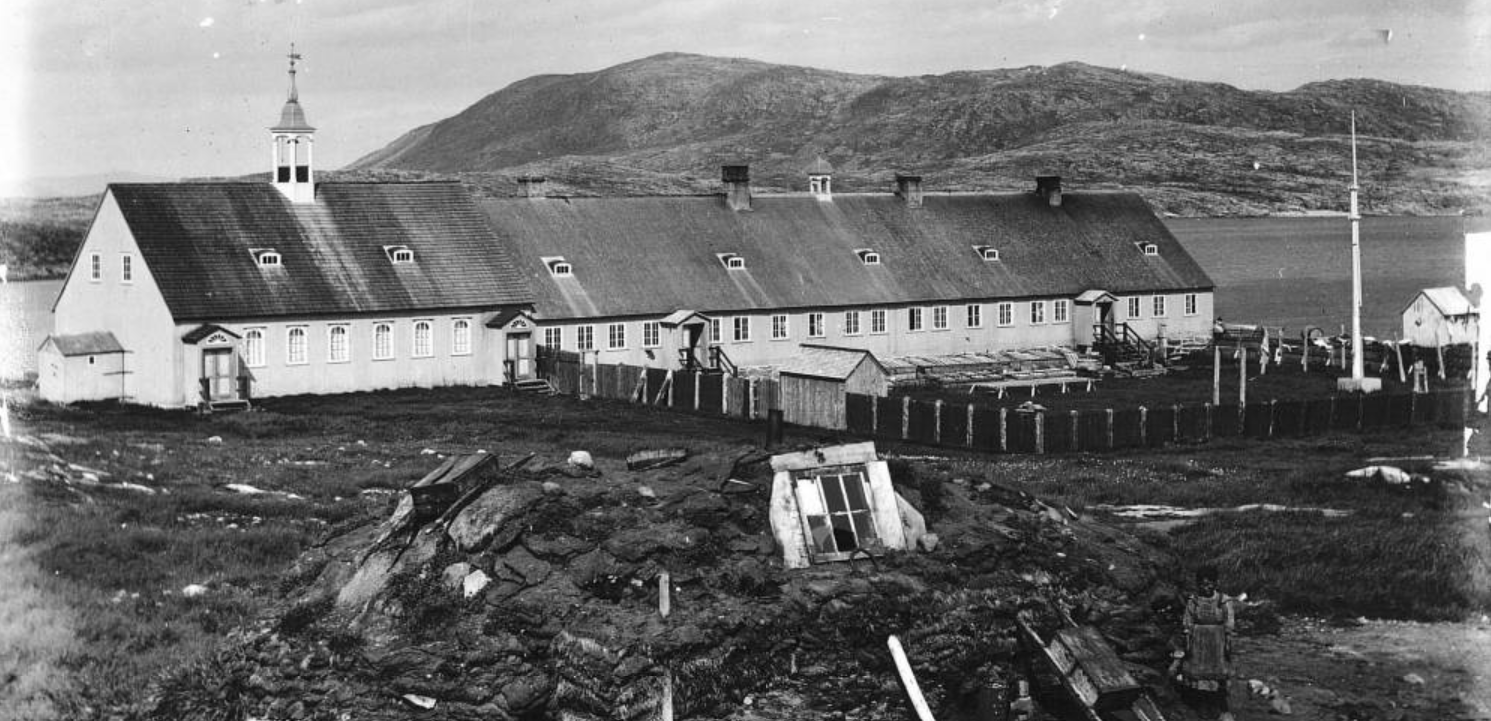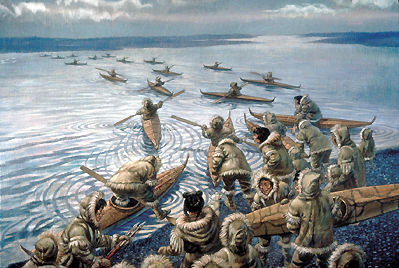In 1771, Moravian missionaries were the first Europeans to settle in Labrador. Over a 133-year period, they established a series of eight missions along the coast which became the focus of religious, social and economic activities for the Inuit who gradually came to settle near the communities. Moravians had a huge impact on the life and culture of Labrador Inuit. What emerged was a unique culture rooted in Inuit traditions with indigenized European practices. The last Moravian missionary left Labrador in 2005, but the Moravian church, its customs and traditions are still very much alive in Labrador.

Initial Attempts to Create a Mission in Labrador
In 1752, Moravian missionary Johann Christian Erhardt organized a trading and missionary expedition to Labrador. The Moravian missionaries were representatives of the Protestant Moravian Church (see Moravian Canadians). When the group arrived, they anchored in a bay near today’s Makkovik, and prepared to establish the first Moravian station in Labrador. They named it Hoffnungsthal (“the valley of hope” or “Hopedale”). While four missionaries were attempting to erect a log house, digging and planting gardens, Erhardt, the ship’s captain and five crew members headed north to trade with Inuit. The group never returned, victims of the violent and troubled relationship that existed between Labrador Inuit and Europeans in those days. The remaining members of the crew and the missionaries abandoned the site and hastily sailed to Europe.
It took 10 years, and the end of the Seven Years’ War in 1763, before another Moravian missionary dared to resume Erhardt’s mission. Jens Haven engaged in three exploration journeys (1764, 1765 and 1770) with the consent and help of Hugh Palliser, the British Governor of Newfoundland. Palliser supported the Moravians’ efforts in the hope that their presence would help resolve Inuit-European tensions.

Mikak's Role
During Haven’s 1765 visit, he travelled with Hugh Palliser to Labrador where they were introduced to an Inuk woman named Mikak (Inuk is the singular form of the word Inuit). In 1767, during an altercation in southern Labrador, Mikak was taken hostage by the British. While in captivity, she began learning English and teaching Inuktitut. Palliser realized that Mikak would be an asset to improve the Inuit-European relationship. He requested that she be brought to London, England, to learn about English culture. Mikak arrived in England in 1768. There, she saw Jens Haven again and came to support his efforts to set up a Moravian mission in Labrador. She made such an impression on the English aristocracy that she is credited with contributing to the Moravians obtaining a royal grant of 100,000 acres of land in Labrador.
Upon her return home in 1769, Mikak’s stories of her experiences in England fascinated the Inuit community. She used her influence to promote the idea of a Moravian mission among her people. She explained how well she was received in England and stated her interest in the missionaries’ teachings. When Haven arrived in Labrador in 1770, he was worried, remembering the fate of Erhardt and his companions. Mikak reassured him that the Inuit would treat them kindly and trade with them justly, if only they came.
Establishment of the First Permanent Mission
The following year, in 1771, Jens Haven, his new bride, two other married couples and eight single men founded the first permanent Moravian settlement in Labrador’s north coast. They chose the Inuit gathering area known as Nuneingoak as the site of their new home and named the station “Nain.” Nain was the first Christian mission for the Inuit in Canada.
Moravian missionaries were not only aiming to bring Christianity to the Inuit; they also were there to cater to their material needs and intended to use trade to finance their missions. By using their trading monopoly and isolating the Inuit from Europeans, the Moravians succeeded in restoring peace as Hugh Palliser was hoping.
Using Nain as their base, the Moravians began to explore the Labrador coast. Having a presence where the Inuit travelled would give them easier access to the Inuit harvest. It would also ensure that the converted Inuit would not go back to their traditional ways and beliefs when not living at the missions.

Moravian Missions Along the Labrador Coast
Over a 133-year period, Moravian missionaries established a series of eight missions along the Labrador coast. Each station generally had a communal dwelling house and church in German architectural style, a trading store, a graveyard, and workshops, as well as sizable vegetable and flower gardens.
Nain (1771-) — The first Moravian mission was positioned centrally among the missions. Today, Nain is the most northerly community on the Labrador coast and is Nunatsiavut’s administrative centre (see Labrador Inuit).
Okak (1776-1919) — About 110km north of Nain. It was closed after the Spanish influenza epidemic of 1918-19 killed more than two-thirds of its residents. Until its closure, Okak was the largest Inuit community on Labrador’s north coast.
Hopedale (1782-) — About 150km south of Nain (by air). It was named to commemorate the failed 1752 settlement attempt (Hoffnungsthal). Hopedale’s mission buildings are a National Historic Site and the oldest timber-framed buildings in Canada east of Quebec. Hopedale is now the legislative capital of the Nunatsiavut Government.
Hebron (1830-1959) — About 100km north of Okak. Hebron’s mission building is a National Historic Site.
Zoar (1865-94) — About midway between Nain and Hopedale.
Ramah (1871- c. 1908) — About 80km north of Hebron. It opened on the 100th anniversary of the first mission in Labrador.
Makkovik (1896-) — About 80km south of Hopedale.
Killinek (1904-24) — Located near Cape Chidley, the very tip of the Labrador peninsula. Was the most northerly mission in Labrador.
Finally, the construction of an air base at Goose Bay during the Second World War led to the opening of Moravian churches in Happy Valley-Goose Bay and Northwest River and a fellowship in Postville.
Moravians as Traders
From the beginning, the trade aspect of the missions was difficult and not always profitable. Missions relied heavily on goods purchased from the Inuit and the once-a-year visit of their supply ship Harmony. Labrador products exported to Europe included oil, sealskins, furs, dried fish and handicrafts.
Moravians were careful to sell goods to the Inuit at moderate prices. They would also offer credit during the harsh winter months and relief to widows and poorer families. By the mid-1800s, the missions were in serious financial trouble, but new stations were nevertheless opened. At the height of its power, the Moravians’ trade monopoly extended 800km, from Groswater Bay to Killiniq Island.
Closing of the Missions
In 1894, a first station closed, Zoar. In 1907, the number of missionaries was cut back (no more than 40 missionaries were posted in Labrador at any point in time). Finally, in 1926, the decision was made to hand over trade operations to the Hudson’s Bay Company.
In 2005, after a 234-year presence, the Moravian Church recalled its last missionary in Labrador, Reverend Sam Propsom. However, the Moravian Church is still very much alive in Labrador. Almost 80 per cent of the people living in Nunatsiavut are of Moravian faith. Today, they administer their own churches.

The Moravians' Legacy
Moravians had a huge impact on the life of Labrador Inuit, both good and bad. Among others, they introduced:
- A written language and literacy in Inuktitut. Labrador Inuit (Labradormiut) are the first Inuit in Canada to have written in their own language
- A new religion (Christianity) which banned the Inuit’s traditional beliefs
- The settlement lifestyle encouraging the Inuit to abandon their nomadic practices
- A new time management system with clocks and calendars
- The concept of debt and mortgage
- Early forms of self-governance through Councils of Elders
- New technologies for hunting, fishing and clothing
Perhaps the Moravians’ most precious legacy in Labrador is their music, which was central to worship and community life. Over the years, Inuit musicians and choristers copied out 18th-century European music, adapting it to their own culture. By doing so, Inuit were reshaping Mozart’s or Haydn’s music, giving it their own voice. The Inuit eventually began teaching each other European music. With the decline of missionary influence in the 20th century, the Inuit have taken control of the musical tradition. This tradition lives on through the Moravian Inuit brass bands which have greeted the arrival of ships, sounded joyful celebrations, or comforted the communities during moments of loss, often from the church rooftop.
Moravian missionaries also carefully recorded daily events and activities. Documents written in Labrador were translated from Inuktitut and shared with Moravian missions worldwide. Likewise, Moravians and Labrador Inuit regularly read accounts from missions around the globe. Moravian archives in Herrnhut (Germany), Bethlehem (Pennsylvania) and London (England) are gold mines of written and visual documentation on the history of the missionaries’ life with the Labrador Inuit.
Moravian Residential Schools
From 1906 to 1980, the Moravian Church and the International Grenfell Association operated residential schools in Newfoundland and Labrador. These organizations operated 5 institutions. Survivors of these institutions faced similar experiences to other residential school survivors (see Residential Schools in Canada).
The federal government apology on residential schools in 2008 did not include survivors of Newfoundland and Labrador residential schools. Following this, 5 class-action lawsuits were initiated in relation to these residential schools. In 2015, a settlement agreement was reached with the provincial government. In 2016, they reached a settlement agreement with the federal government. In 2017, Prime Minister Justin Trudeau visited Happy Valley-Goose Bay. During this trip, he apologized to survivors of the residential schools. However, some challenge the apology as it only includes survivors who attended residential schools after Newfoundland and Labrador joined Canada.

 Share on Facebook
Share on Facebook Share on X
Share on X Share by Email
Share by Email Share on Google Classroom
Share on Google Classroom










